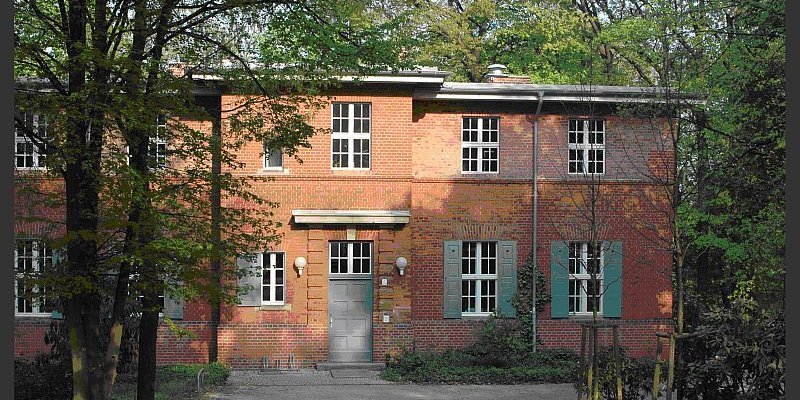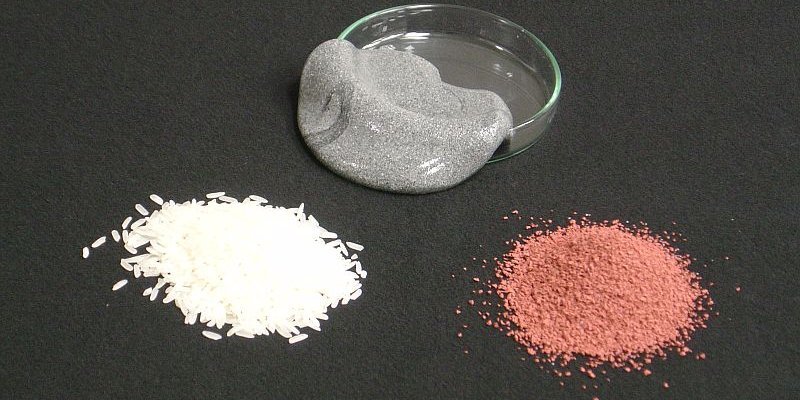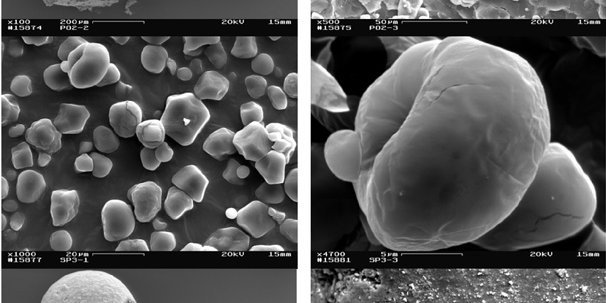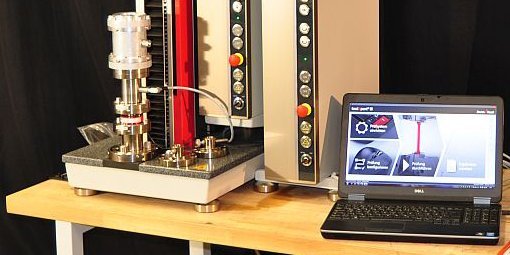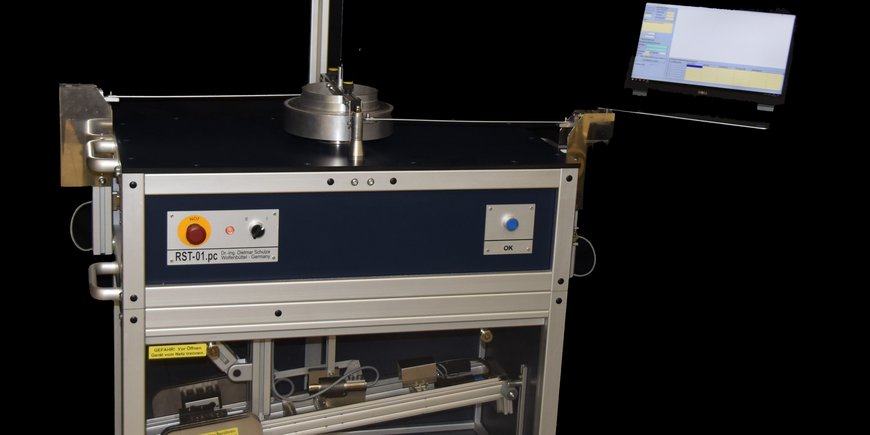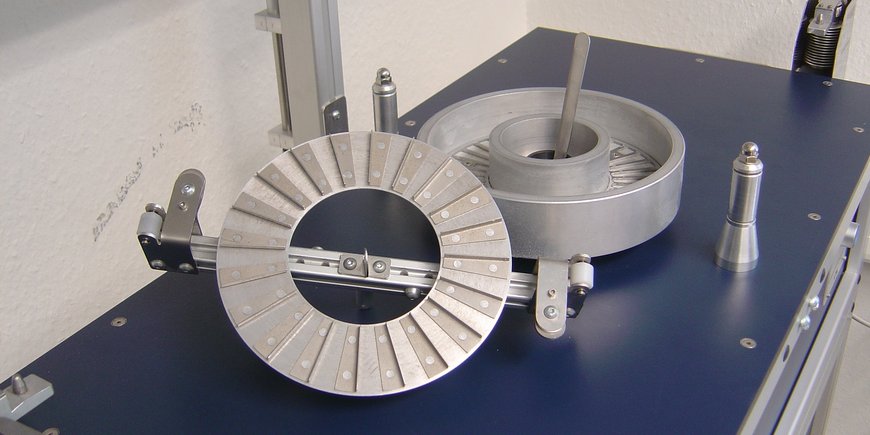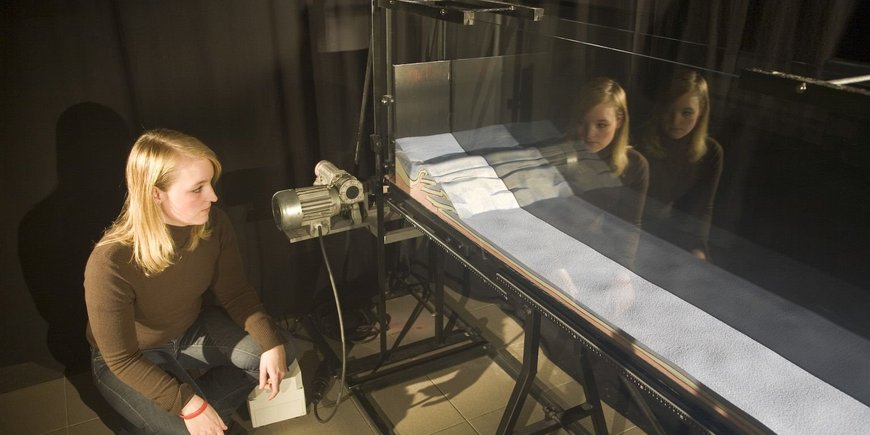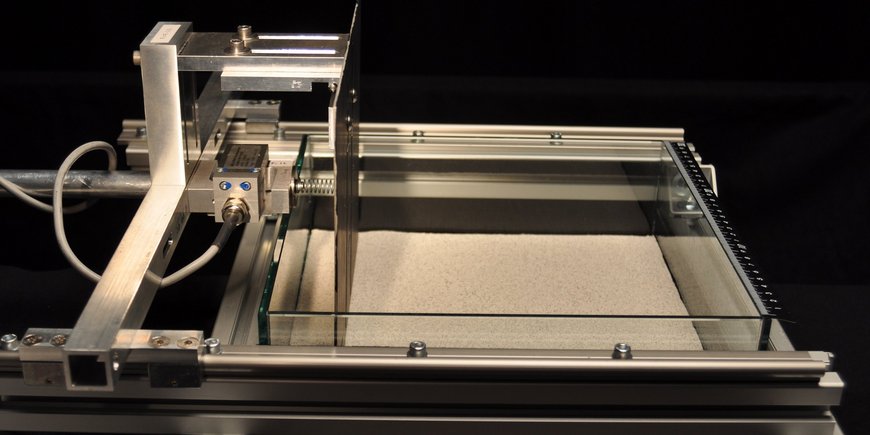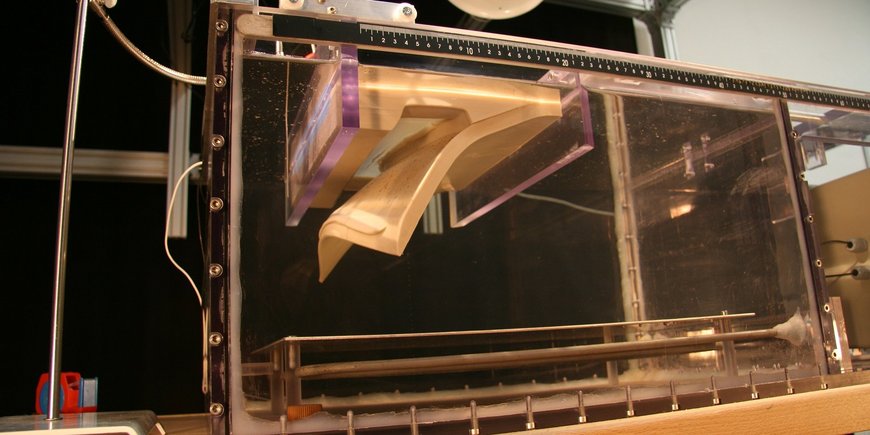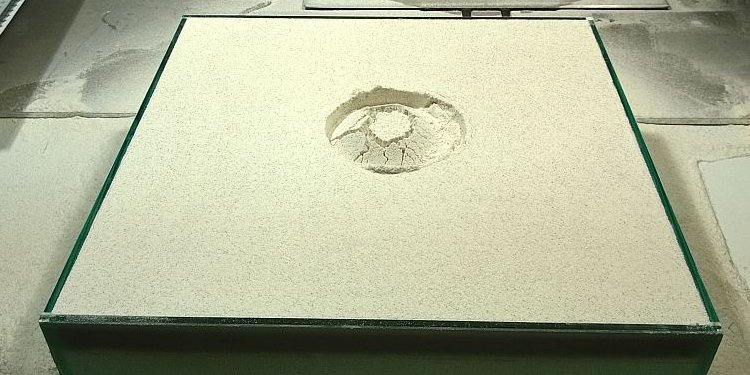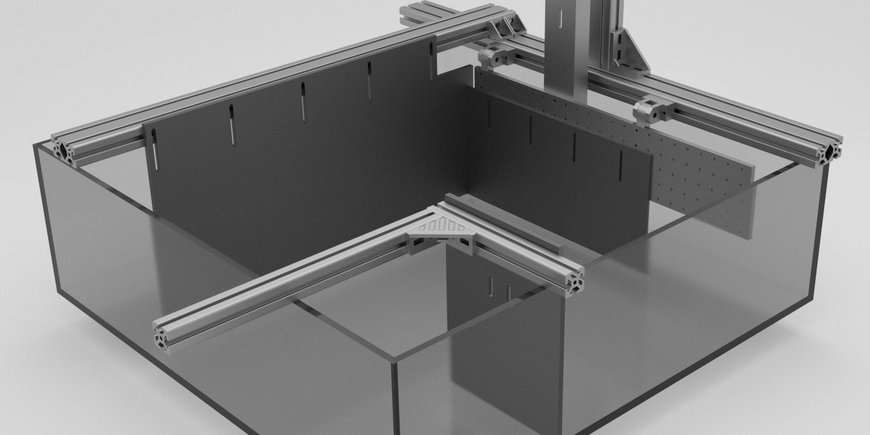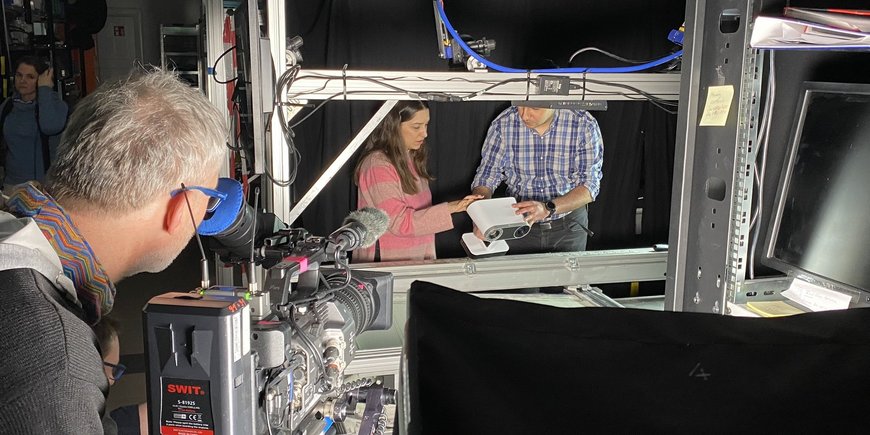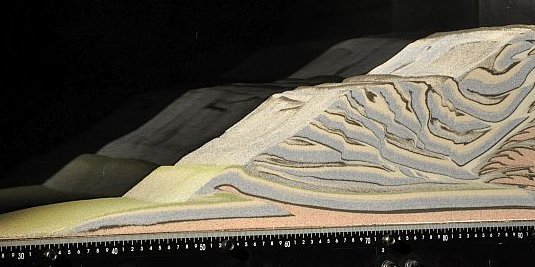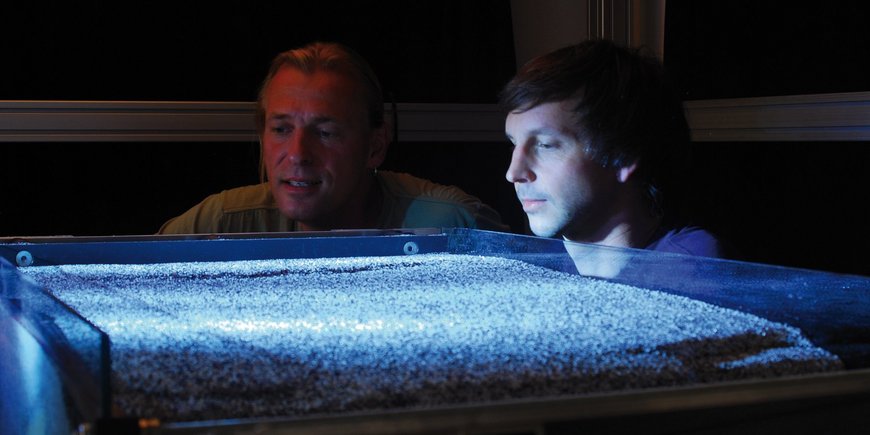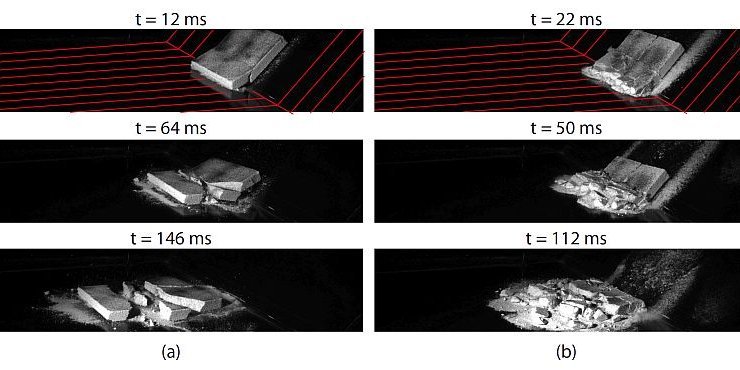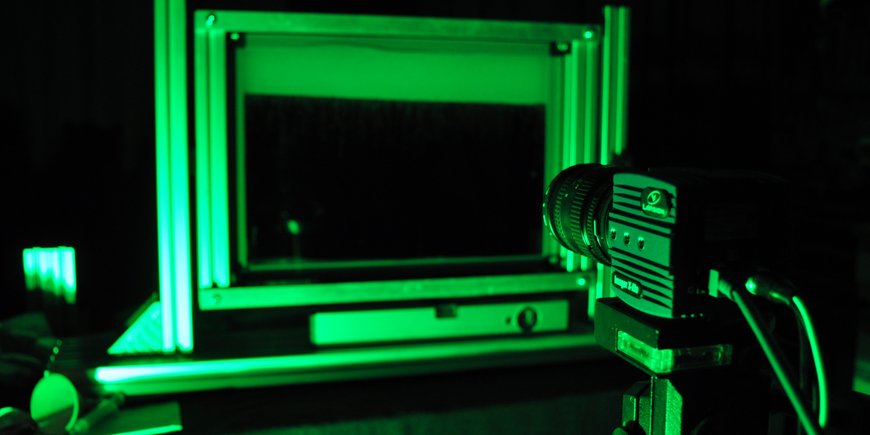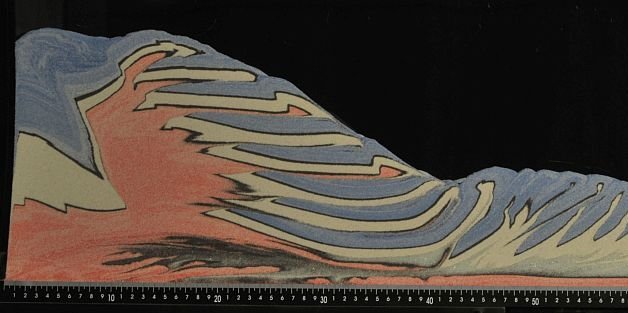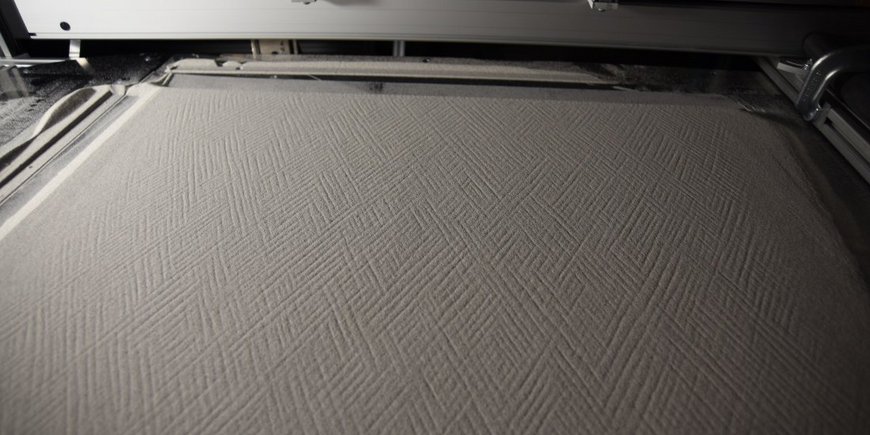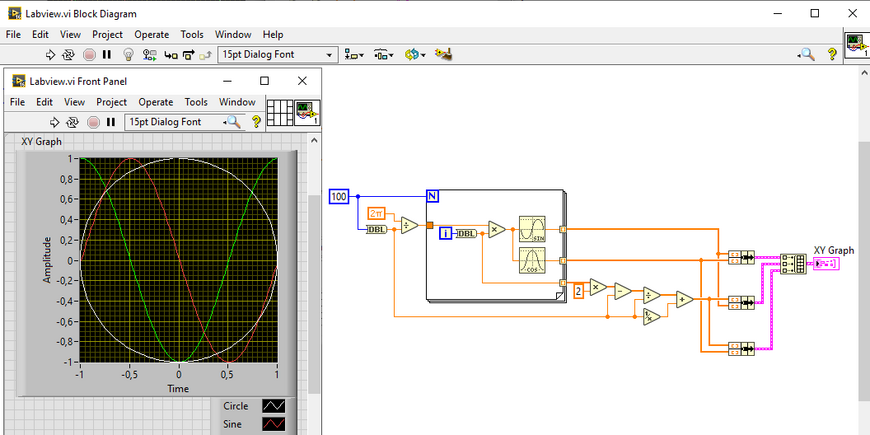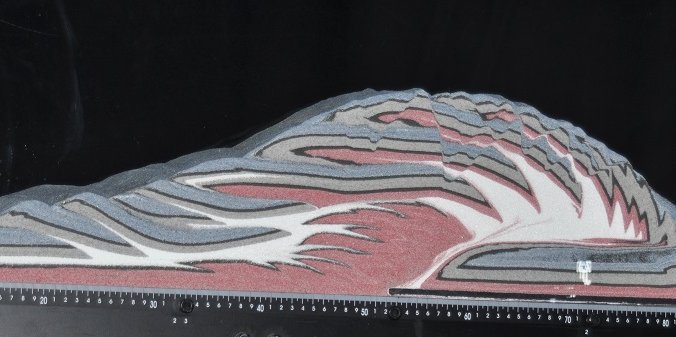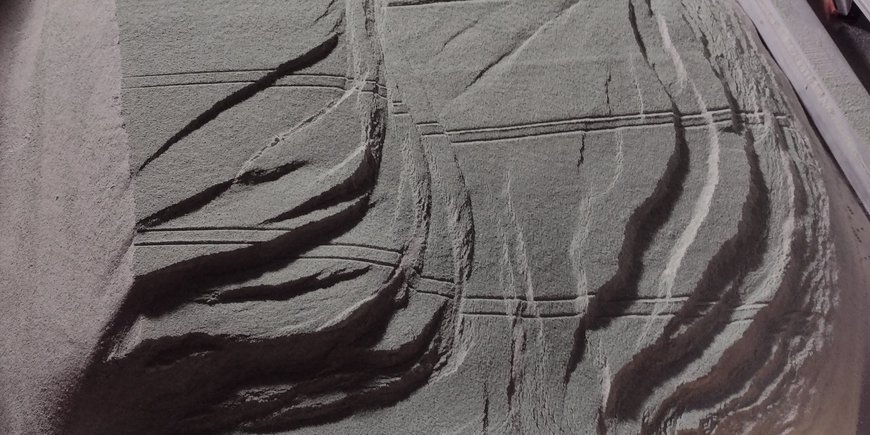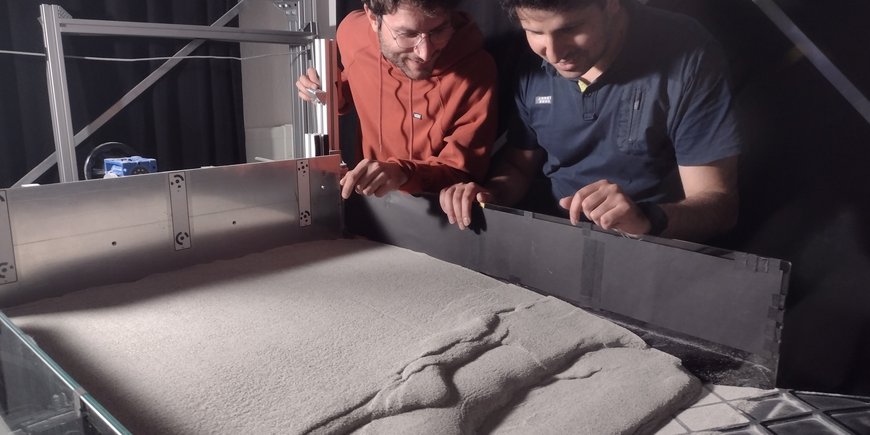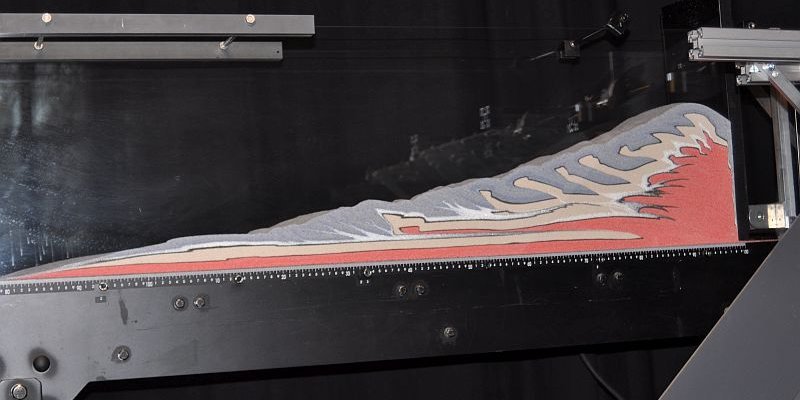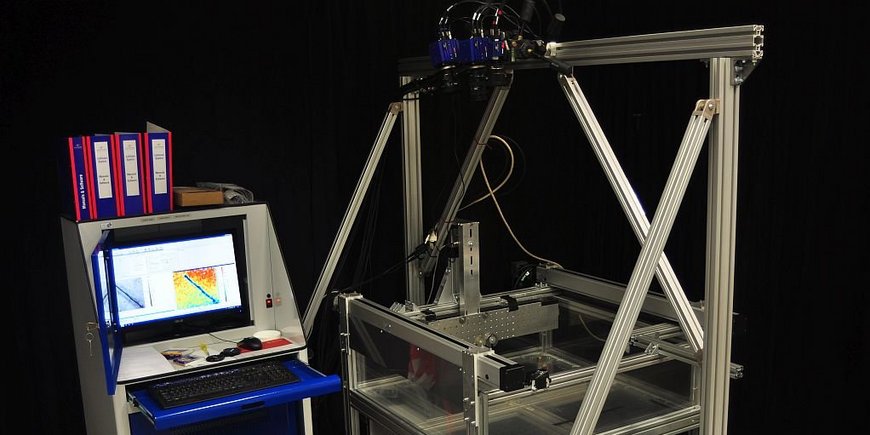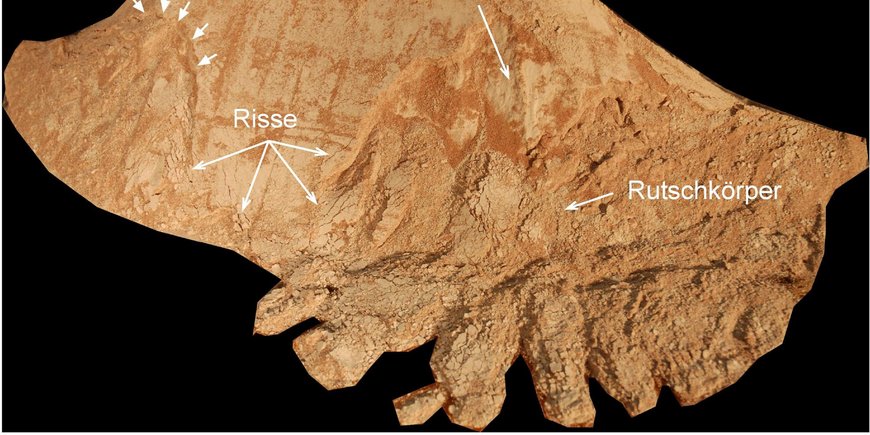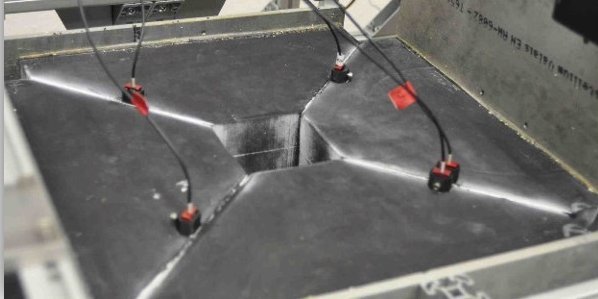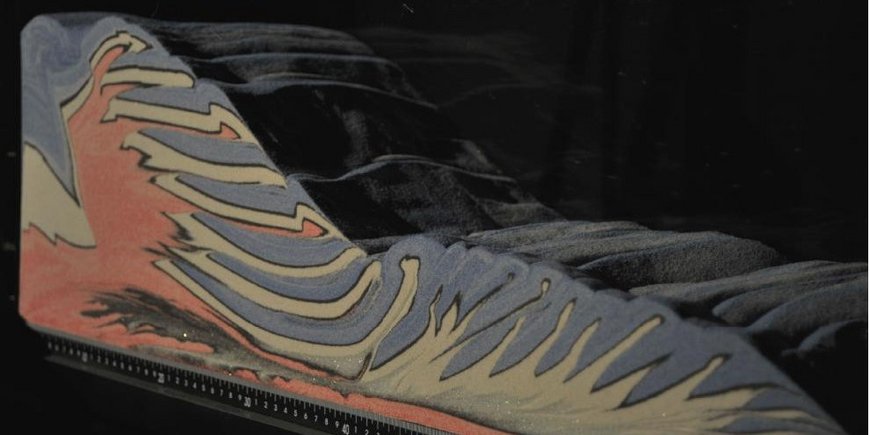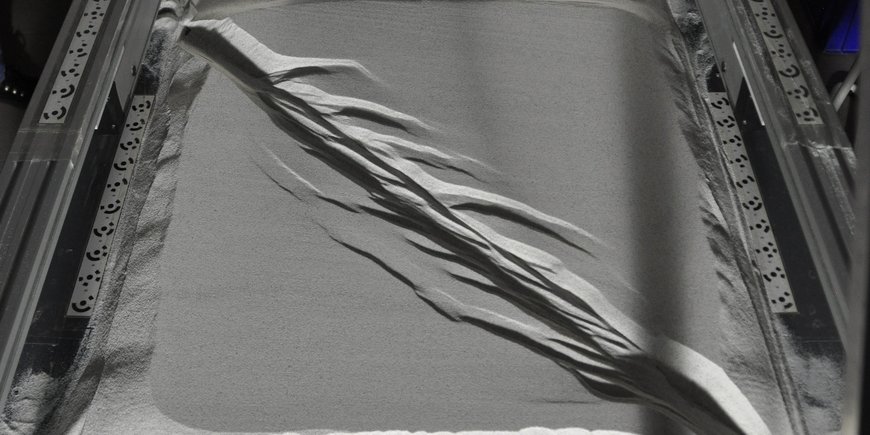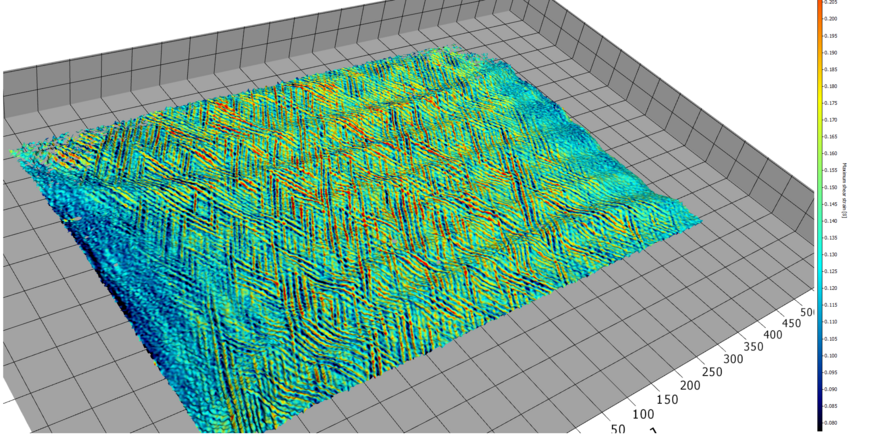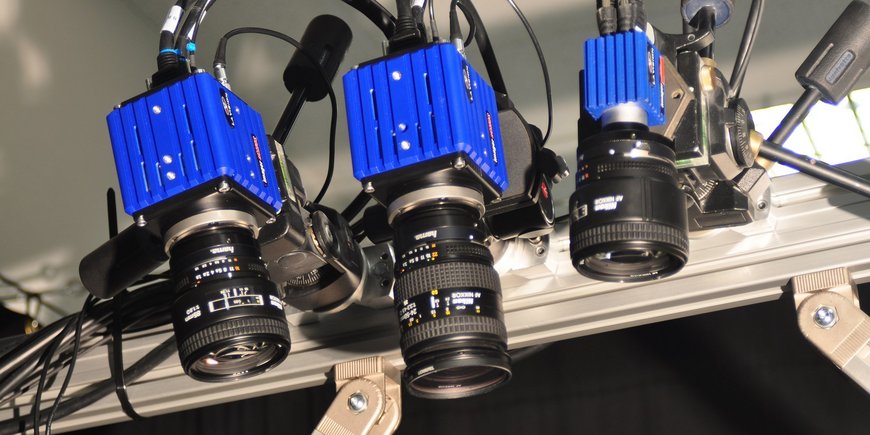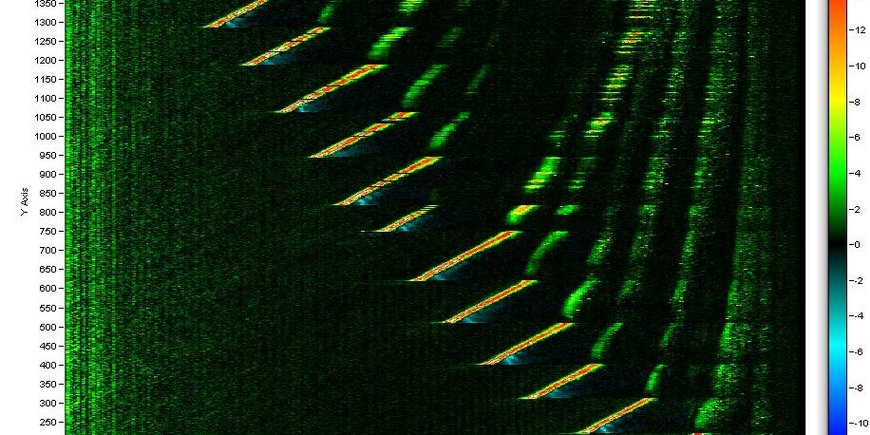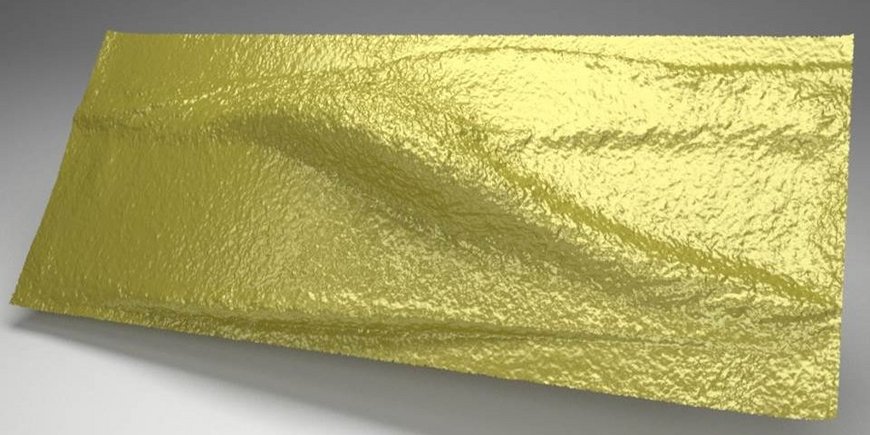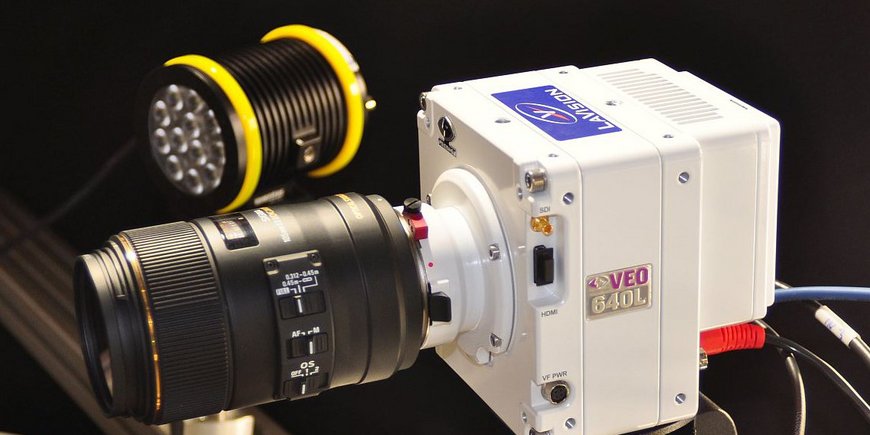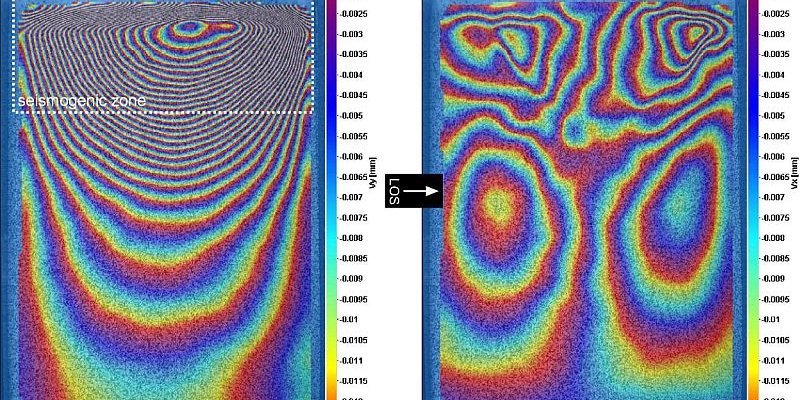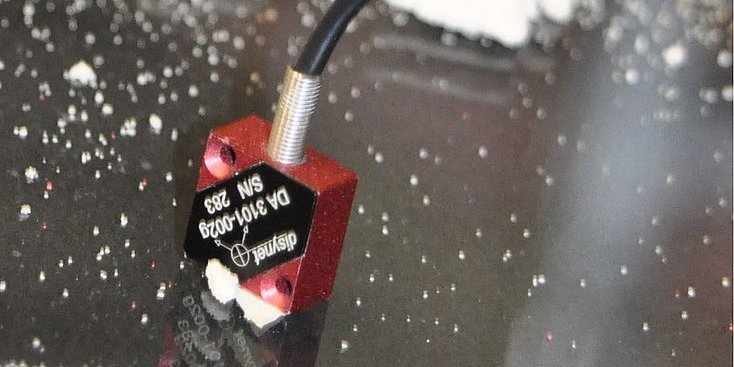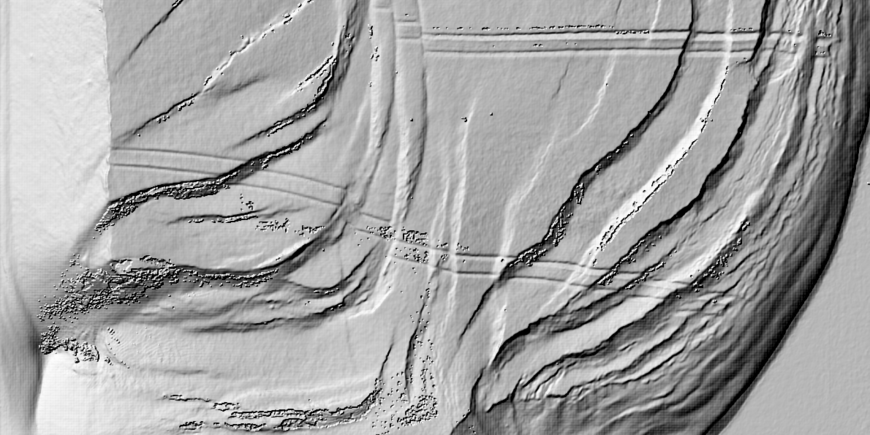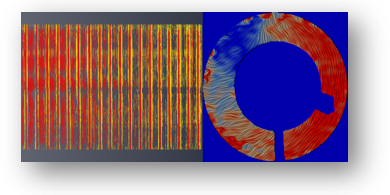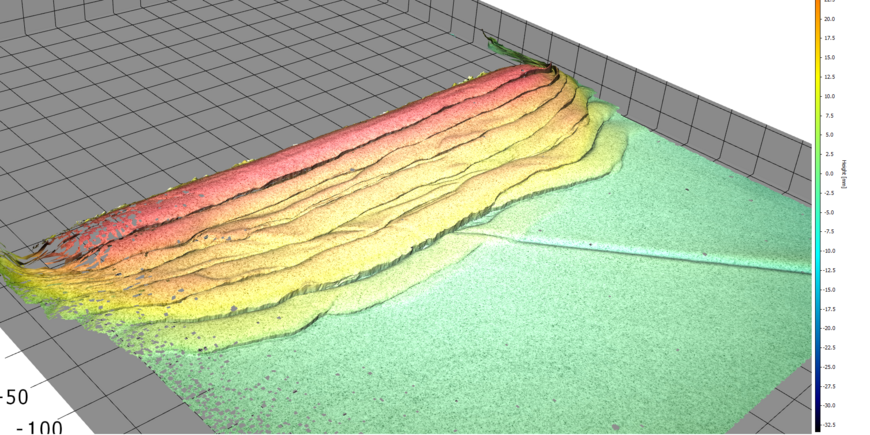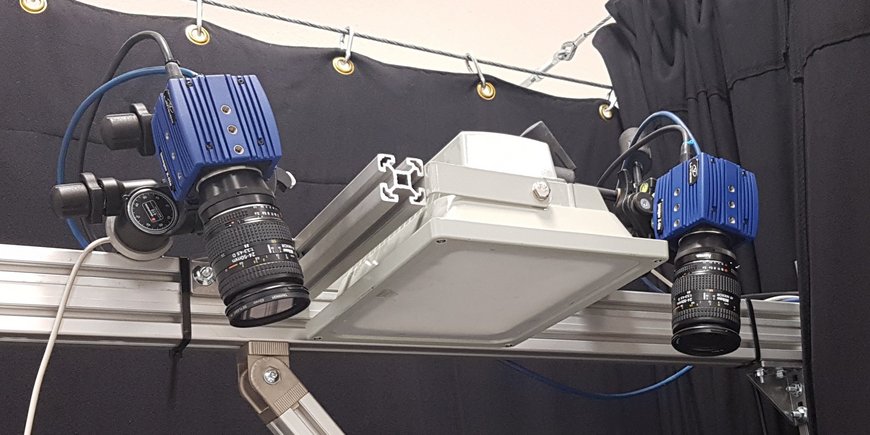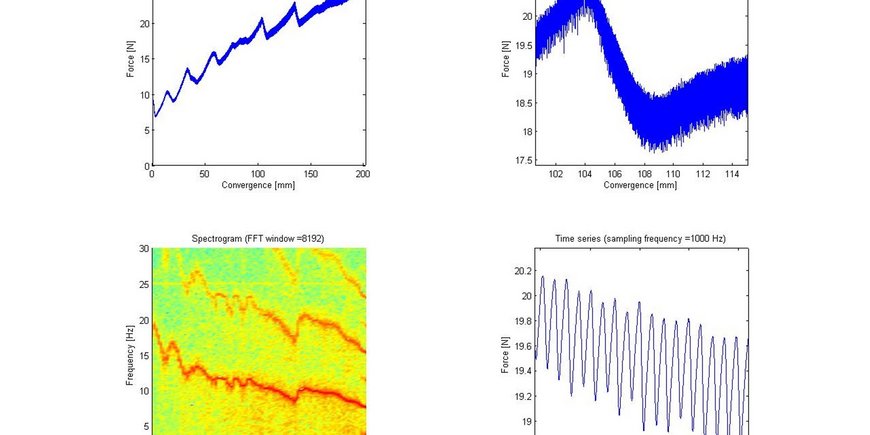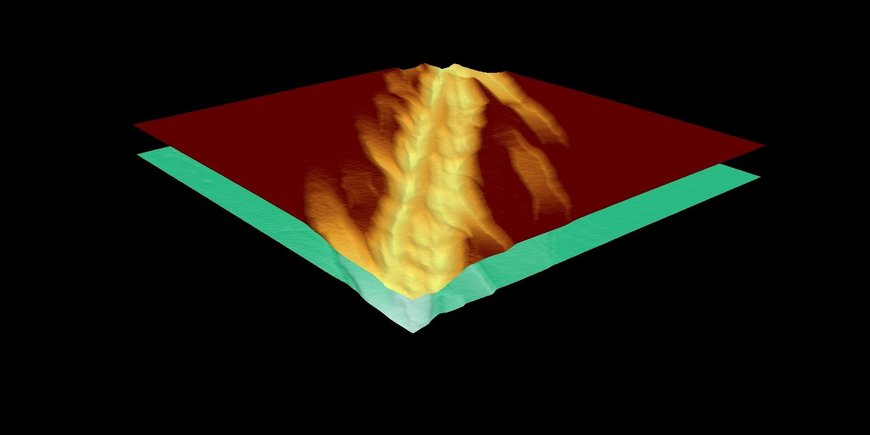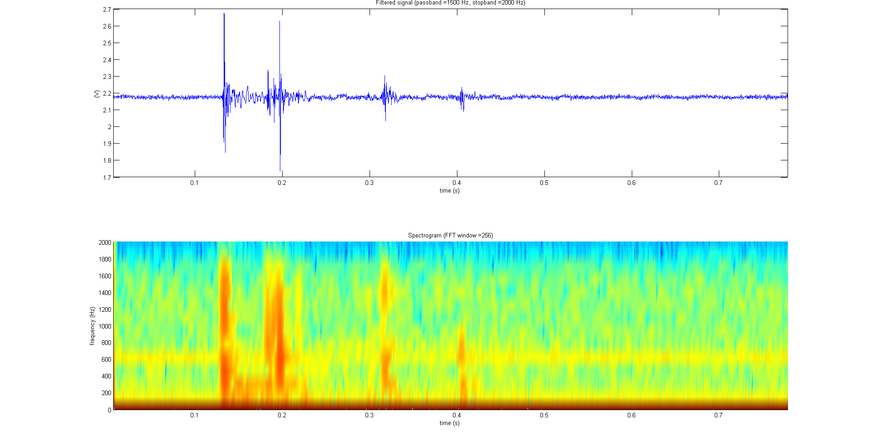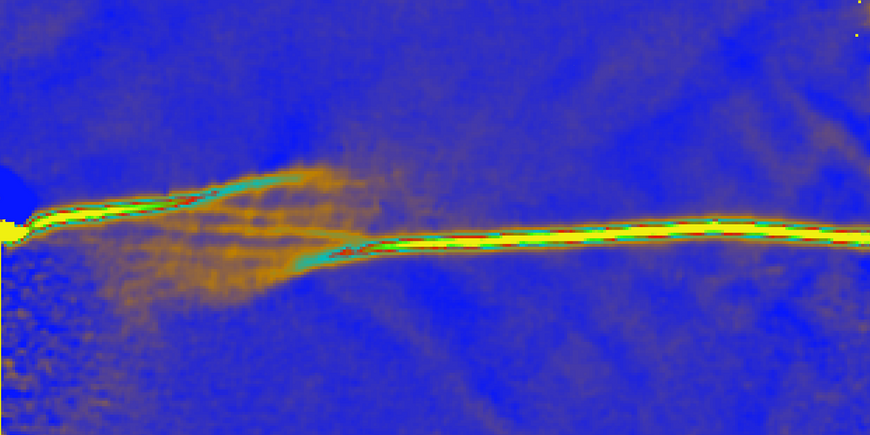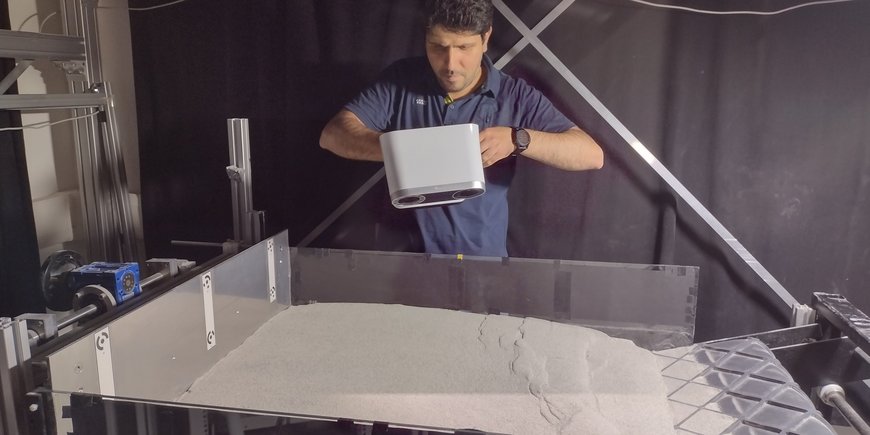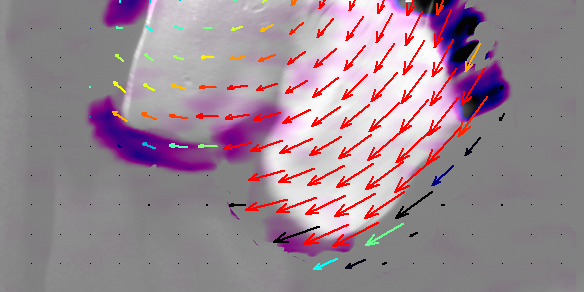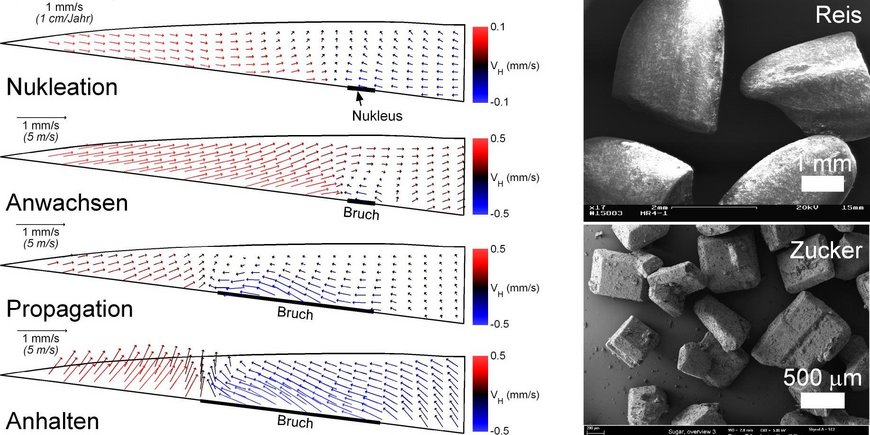HelTec - Laboratory for experimental tectonics at the Helmholtz Centre Potsdam GFZ
Experimental tectonics is the branch of geosciences that uses so-called "analogue models" scaled down from nature to the laboratory to study tectonic processes "in situ". Thanks to new materials, testing methods and monitoring techniques, which have been developed in the past two decades, anologue modelling nowadays provides quantitative tectonic oberservations across all relevant spatial and temporal scales. Please find an introductory texts to our lab and methods here and here.
Our experimental tectonics lab facility consists of three basic modules:
1) Material testing featuring a series of material test devices for characterizing rock analogue materials’ properties including friction, elasticity, viscosity etc.
2) Analogue modelling featuring a suite of custom-made deformation devices for simulating (seismo)tectonic and other geological processes
3) Laboratory monitoring providing the means of quantifying deformation in analogue models using various sensors and image correlation methods
Material testing
- Rheometer Anton Paar MCR301 (Visco-elastic properties)
- Ring-shear tester Schulze RST-01(Frictional properties) > video
- Rotational axial/triaxial tester Zwick-Roell Zwickiline (Elasto-plastic properties)
Analogue modelling
- Compressional, extensional, strike-slip tectonics
- Gravitational flow
- Magmatic intrusion & volcano-tectonics
- Meteoritic impact
Laboratory monitoring
- Laboratory geodesy & seismology
- High resolution to high speed digital imaging: 5-50 MPx, 1-10.000 Hz (LaVision Imager, Phantom VEO)
- Digital image correlation: DIC/PIV (LaVision Strainmaster) & SfM (Agisoft Metashape)
- Laser scanning (Artec3D Leo)
- Force sensors, MEMS accelerometers & piezotransducers (static to kHz/MHz dynamic)
Projects, theses & fellowships:
- Tectonics
- Triaxial tectonics (CSC, MSC J. Liu, ongoing)
- East African Rift (A. Muluneh & F. Zwaan/GFZ, 2023)
- Transpression (DAAD, Prof. M. Cooke/UMass, 2022)
- Restraining bends (UMass, H. Elston/UMass, 2022)
- Fold deflection (PHD Secondment M. Maleco, U Soran/IRQ, 2019)
- Fault networks under pure shear (H2020 SUBITOP, Y. Creton, 2019)
- Extension with inheritence (Erasmus/DEEP, E.E. Osagiede, U Bergen/NOR, 2019)
- Trench-trench-transforms (DAAD, Prof. A. Nicol, U Canterbury/NZ, 2018)
- Work budget of tectonic faulting (PHD M. Ritter, FU Berlin, 2017)
- Kinematic complexity in sandbox experiments (PHD T. Santimano, FU Berlin, 2015)
- Subduction erosion (PHD F. Albert, FU Berlin, 2014)
- Bivergent wedges (BSC S. Teuber, U Hamburg, 2014)
- Thermomechanical model of subduction orogeny (Humboldt Fellowship D. Boutelier 2013)
- Indenter tectonis (Diploma K. Reiter, U Freiberg, 2010)
- Fault propagation (Diploma A. Clauß, U Jena, 2010)
- Rifting and extension (PHD T. Lohr, FU Berlin, 2008)
- Plateau formation (PHD K. Schemmann, FU Berlin, 2008)
- Syntectonic sedimentation (Diploma M. Soyka, FU Berlin, 2007)
- Oblique convergence (PHD A. Kellner, U Potsdam, 2007)
- Subduction accretion vs. erosion (Diploma A. Rechlin, U Hamburg, 2006)
- Retrowedge kinematics (Diploma U. Schönrock, U Potsdam, 2006)
- Continental collision zones (PHD S. Hoth, FU Berlin, 2006)
- Makran accretionary wedge (PHD K. Huhn, FU Berlin, 2002)
- Subduction accretion vs. erosion (PHD J. Lohrmann, FU Berlin, 2002)
- EQs & seismic cycles
- EQ triggering in subduction zones (PHD Secondment G. Mastella, Univ. Roma Tre/IT 2022)
- Short- to long-term deformation signals from a laboratory subduction zone (H2020 SUBITOPPHD E. Kosari, 2022)
- Strike-slip earthquakes (Univ. Paris-Cergy, S. Visage, 2021)
- Machine learning based analog earthquake prediction (DAAD PRIME, Dr. Fabio Corbi/IT, 2019-2020)
- Analog strike-slip earthquakes (PHD M. Rudolf, FU Berlin, 2019)
- Megathrust seismic cycle (PHD S. Li, FU Berlin, 2016)
- Rate-state friction model vs. experiment (PHD Secondment Z. Amirzada, U Utrecht/NL 2016)
- Numerics of rate-state friction (PHD E. Pipping, FU Berlin, 2015)
- Analog vs. numerical megathrust earthquakes (Diploma R. Nerlich, FU Berlin, 2009)
- Gravitational mass movements
- Suspension flows (DFG-Math+ Dr M.H. Farshbaf Shaker2022)
- Dynamic rock fragmentation (PHD O. Haug, FU Berlin, 2015)
- Seismological monitoring of landslides (MSC Z. Amirzada, FU Berlin, 2015)
- Submarine landslides (Diploma A. Reiprich, FU Berlin, 2009)
- Material properties
- Effect of sieving height on granular material properties (EPOS TNA, MSC T. Schmid, U Bern/CHE, 2019)
- Material properties benchmark (PHD Secondment M. Klinkmüller, U Bern/CH, 2011)
- Material properties impact on wedging (BSC F. Hofmann, LMU Munich, 2010)
- Monitoring methods
- Surface deformation quantification in rifting experiments (EPOS TNA, MSC T. Schmid, U Bern/CHE, 2019)
- Laboratory seismic imaging (PHD M. Buddensiek, FU Berlin, 2009)
- Volcanotectonics
- Syntectonic intrusion under compression (Dr. Antonella Galetto, Salta/ARG, 2019)
- Syntectonic intrusion under strike-slip and transtension (PHD Secondment M. Michail, U Ferrara/IT 2017)
- Magma emplacement in the crust (PHD S. Burchardt, U Göttingen, 2009)
- Elongated calderas (Diploma K. Müller, U Jena, 2008)
- Salt tectonics & reservoirs
- Critical vs. unstable progradational wedges (EPOS TNA, Dr. Z. Ge, U Bergen/NOR, 2019)
- Progressive vs. instant tilting (EPOS TNA, Dr. Z. Ge, U Bergen/NOR, 2019)
- Translational domain destruction (E.ON Stipendienfond, Dr. Z. Ge, U Bergen/NOR, 2018)
- Salt flow and pillow growth (PHD Secondment M. Warsitzka, U Jena, 2017)
- Fracking (MSC R. Gentzmann, FU Berlin, 2016)
- Salt diapirism (Diploma M. Warsitzka, U Jena, 2010)
- EPOS-IP TCS MSL (EPOS-IP H2020, Dr. M. Warsitzka, 2018)
- Meteoritic impacts
- Impact crater relaxation (MSC S. Teuber, U Hamburg, 2016)
- Overprinting of impact structures (Diploma F. Kiebach, HU Berlin, 2009)
Special issues
Analogue modelling of basin inversion, Solid Earth, Vol. 13/14 (2022/23)
Style of deformation and tectono-sedimentary evolution of fold-and-thrust belts and foreland basins: from nature to models, Tectonophysics, Vol. 767 (2019)
GeoMod 2014 – Modelling in Geoscience, Tectonophysics, Vol. 684 (2016)
Tectonics of oblique plate boundary systems, Tectonophysics, Vol. 693 (2016)
Preprints
Ge et al.: How Topographic Slopes Control Gravity Spreading in Salt-bearing Passive Margins: Insights from Analogue Modelling, ESSOAr,https://doi.org/10.1002/essoar.10506599.3
Peschka & Rosenau: Two-phase flows for sedimentation of suspensions, WIAS Preprint No. 2743, http://dx.doi.org/10.20347/WIAS.PREPRINT.2743
Rosenau et al.: Creep on seismogenic faults: Insights from analogue earthquake experiments, EarthArXiv,https://dx.doi.org/10.31223/osf.io/24u5h
*Guest publications (studies supported by access to or services by HelTec infrastructure)
**Collaborative publications (studies performed mainly in partner lab)
2024
Liu et al. (2024): Fault networks in triaxial tectonic settings: Analogue modeling of distributed continental extension with lateral shortening, Tectonics, https://doi.org/10.1029/2023TC008127 (in press)
**Corbi et al. (2024): Asperity size and neighboring segments can change the frictional response and fault slip behavior: insights from laboratory experiments and numerical simulations, J. Geophys. Res.,https://doi.org/10.1029/2023JB026594 (open access article)
2023
Kosari et al. (2023): Along-strike seismotectonic segmentation reflecting megathrust seismogenic behavior. Geology 2023; doi: https://doi.org/10.1130/G51115.1 >preprint@EarthArXiv
Rudolf et al. (2023): Time-dependent Frictional Properties of Granular Materials Used In Analogue Modelling: Implications for mimicking fault healing during reactivation and inversion, Solid Earth, https://doi.org/10.5194/se-14-311-2023 (open access article)
2022
Zwaan et al. (2022): Analogue modelling of basin inversion: a review and future perspectives, Solid Earth https://doi.org/10.5194/se-13-1859-2022 (open access article)
Elger et al. (2022): The EPOS Multi-Scale Laboratories: A FAIR Framework for stimulating Open Science practice across European Earth Sciences Laboratories, Ann. Geoph. ,https://doi.org/10.4401/ag-8790 (open access article)
Kosari et al. (2022): Upper plate response to a sequential elastic rebound and slab acceleration during laboratory-scale subduction megathrust earthquakes. J. Geophys. Res.,https://doi.org/10.1029/2022JB024143 (open access article)
Kosari et al. (2022): Strain signals governed by frictional-elastoplastic interaction of the upper plate and shallow subduction megathrust interface over seismic cycles, Tectonics, https://doi.org/10.1029/2021TC007099 (open access article)
**Mastella et al. (2022): Forecasting surface velocity fields associated with laboratory seismic cycles using Deep Learning, Geoph. Res. Lett., https://doi.org/10.1029/2022GL099632 (open access article)
**Mastella et al. (2022): Foamquake: a novel analog model mimicking megathrust seismic cycles, J. Geoph. Res., https://doi.org/10.1029/2021JB022789
2021
Rudolf et al. (2021): The spectrum of slip behaviours of a granular fault gouge analogue governed by rate and state friction, Geoch. Geoph. Geos., https://doi.org/10.1029/2021GC009825 (open access article)
Osagiede et al. (2021): Influence of zones of pre-existing crustal weakness on strain localization and partitioning during rifting: Insights from analogue mode ling using high resolution 3D digital image correlation, Tectonics, https://doi.org/10.1029/2021TC006970 (open access article)
Michail et al. (2021): Shape of plutons in crustal shear zones: A tectono-magmatic guide based on analogue models, J. Struct. Geol., https://doi.org/10.1016/j.jsg.2021.104417 >preprint@EarthArXiv
Haug et al. (2021): Runout of rock avalanches limited by basal friction but controlled by fragmentation, Earth Surf. Dynam., https://doi.org/10.5194/esurf-9-665-2021 (open access article)
**Zwaan et al. (2021): How initial basin geometry influences gravity-driven salt tectonics: insights from laboratory experiments, Mar. Petrol. Geol., https://doi.org/10.1016/j.marpetgeo.2021.105195 (open access article)
**Poppe et al. (2021): Mechanical properties of quartz sand and gypsum powder (plaster) mixtures: Implications for laboratory model analogues for the Earth’s upper crust, Tectonophysics, https://doi.org/10.1016/j.tecto.2021.228976 >preprint@EarthArXiv
*Schmid et al. (2021): Characteristics of continental rifting in rotational systems: New findings from spatiotemporal high resolution quantified crustal scale analogue models, Tectonophysics, https://doi.org/10.1016/j.tecto.2021.229174 (open access article)
2020
Funiciello et al. (2020): Analysis of global-scale and experimental data to unravel the seismic behaviour of the subduction megathrust, Front. Earth Sci., https://doi.org/10.3389/feart.2020.600152 (open access article)
Kosari et al. (2020): On the relationship between offshore geodetic coverage and slip model uncertainty: Analog megathrust earthquake case studies, Geoph. Res. Lett,https://doi.org/10.1029/2020GL088266(open access article)
**Corbi et al. (2020): Predicting imminence of analog megathrust earthquakes with Machine Learning: Implications for monitoring subduction zones. Geoph. Res. Lett., https://doi.org/10.1029/2019GL086615 (open access article)
**Zwaan et al. (2020): Rift propagation in rotational versus orthogonal extension: insights from 4D analogue models, J. Struct. Geol.,https://doi.org/10.1016/j.jsg.2019.103946
*Zorn et al. (2020): Insights into lava dome and spine extrusion using analogue sandbox experiments, Earth Planet. Sci. Lett., https://doi.org/10.1016/j.epsl.2020.116571
2019
Ge et al. (2019): Progressive tilting of salt-bearing continental margins controls thin-skinned deformation. Geology, https://doi.org/10.1130/G46485.1 (open access article)
Ge et al. (2019): Overprinting translational domains in passive margin salt basins: Insights from analogue modelling, Solid Earth, https://doi.org/10.5194/se-10-1283-2019 (open access article)
Lacombe et al. (2019): Style of deformation and tectono-sedimentary evolution of fold-and-thrust belts and foreland basins: From nature to models, Tectonophysics, https://doi.org/10.1016/j.tecto.2019.228163.
Rosenau et al. (2019): Synchronization of great subduction megathrust earthquakes: Insights from scale model analysis. J. Geoph. Res.,https://doi.org/10.1029/2018JB016597 >copy@GFZPublic
Rudolf et al. (2019): Smart speed imaging in Digital Image Correlation: Application to seismotectonic scale modelling, Front. Earth Sci., https://doi.org/10.3389/feart.2018.00248 (open access article)
**Corbi et al. (2019): Machine Learning can predict the timing and size of analog earthquakes. Geoph. Res. Lett., https://doi.org/10.1029/2018GL081251 >copy@GFZPublic
2018
Li et al. (2018): Spatiotemporal variation of mantle viscosity and the presence of cratonic mantle inferred from eight years of postseismic deformation following the 2010 Maule Chile earthquake, Geoch. Geoph. Geosys. , https://doi.org/10.1029/2018GC007645 >copy@GFZpublic
Albert et al. (2018): Material transfer and subduction channel segmentation at erosive continental margins: Insights from scaled analogue experiments, Tectonophysics, https://doi.org/10.1016/j.tecto.2018.10.019
Ritter et al. (2018): Growing Faults in the Lab: Insights into the Scale Dependence of the Fault Zone Evolution Process, Tectonics, https://doi.org/10.1002/2017TC004787 >copy@GFZpublic
Ritter et al. (2018): Sandbox rheometry: Co-evolution of stress and strain in Riedel– and Critical Wedge–experiments, Tectonophysics, https://doi.org/10.1016/j.tecto.2017.11.018
2017
Rosenau et al. (2017): Analogue earthquakes and seismic cycles: Experimental modelling across timescales, Solid Earth, https://doi.org/10.5194/se-8-597-2017 (open access article)
Li et al. (2017): Postseismic uplift of the Andes following the 2010 Maule earthquake: Implications for mantle rheology, Geoph. Res. Lett., https://doi.org/10.1002/2016GL071995 >copy@GFZpublic
**Corbi et al. (2017): Control of asperities size and spacing on seismic behavior of subduction megathrusts, Geoph. Res. Lett., https://doi.org/10.1002/2017GL074182 >copy@GFZpublic
*de Zeeuw-van Dalfsen et al. (2017): Geomorphology and structural development of the nested summit crater of Láscar Volcano studied with Terrestrial Laser Scanner data and analogue modelling, J. Volc. Geoth. Res., http://dx.doi.org/10.1016/j.jvolgeores.2016.09.018
2016
Rosenau et al. (2016): Experimental Tectonics: Convergent Plate Margins, Ref. Mod. Earth Syst. Env. Sci.,http://dx.doi.org/10.1016/B978-0-12-409548-9.09497-5
Ritter et al. (2016): Scaling the Sand Box - Mechanical (Dis-) Similarities of Granular Materials and Brittle Rock, J. Geoph. Res., https://doi.org/10.1002/2016JB012915 >copy@GFZpublic
Haug et al. (2016): On the Energy Budgets of Fragmenting Rockfalls and Rockslides: Insights from Experiments, J. Geoph. Res., https://doi.org/10.1002/2014JF003406 >copy@GFZpublic
Leever & Oncken (2016), GeoMod 2014 – Modelling in geoscience, Tectonophysics, http://doi.org/10.1016/j.tecto.2016.06.034
Díaz-Azpiroz et al. (2016): Tectonics of oblique plate boundary systems. Tectonophysics, https://doi.org/10.1016/j.tecto.2016.07.028
Schreurs et al. (2016): Benchmarking analogue models of brittle thrust wedges, J. Struct. Geol., https://doi.org/10.1016/j.jsg.2016.03.005
Klinkmüller et al. (2016):Properties of granular analogue materials: A community wide survey, Tectonophysics, 666, https://doi.org/10.1016/j.tecto.2016.01.017 >preprint@GFZpublic
Pipping et al. (2016): On the efficient and reliable numerical solution of rate-and-state friction problems, Geoph. J. Int., https://doi.org/10.1093/gji/ggv512 >copy@GFZpublic
Rudolf et al. (2016): Rheological benchmark of silicone oils used for analog modeling of short- and long-term lithospheric deformation, Tectonophysics, http://dx.doi.org/10.1016/j.tecto.2015.11.028
2015
Santimano et al. (2015): Intrinsic versus extrinsic variability of analogue sand-box experiments - Insights from statistical analysis of repeated accretionary sand wedge experiments, J. Struct. Geol., https://doi.org/10.1016/j.jsg.2015.03.008
Di Giuseppe et al. (2015): Characterization of Carbopol hydrogel rheology for experimental tectonics and geodynamics, Tectonophysics, https://doi.org/10.1016/j.tecto.2014.12.005
Li et al. (2015): Revisiting viscoelastic effects on interseismic deformation and locking degree: A case study of the Peru-North Chile subduction zone, J. Geoph. Res., https://doi.org/10.1002/2015JB011903 >copy@GFZpublic
Warsitzka et al. (2015): Analogue experiments of salt flow and pillow growth due to basement faulting and differential loading, Solid Earth, https://doi.org/10.5194/se-6-9-2015 (open access article)
2014
Haug et al. (2014): Modelling Fragmentation in Rock Avalanches. In: Landslide Science for a Safer Geoenvironment, Volume 2: Methods of Landslide Studies, K. Sassa, P. Canuti, Y. Yin (eds.), Springer International Publishing, Cham, https://doi.org/10.1007/978-3-319-05050-8_16
Leever et al. (2014): The Science Behind Laboratory-Scale Models of the Earth, Eos Trans. AGU, https://doi.org/10.1002/2014EO030008
Li et al. (2014): Splay fault triggering by great subduction earthquakes inferred from finite element models, Geoph. Res. Lett., https://doi.org/10.1002/2013GL058598
**Boutelier et al. (2014): Trench-parallel shortening in the forearc caused by subduction along a seaward-concave plate boundary: Insights from analogue modelling experiments, Tectonophysics, https://doi.org/10.1016/j.tecto.2013.11.028
*Le Corvec et al. (2014): Experimental study of the interplay between magmatic rift intrusion and flank instability with application to the 2001 Mount Etna eruption, J. Geoph. Res., https://doi.org/10.1002/2014JB011224
*Kervyn et al. (2014): Directional flank spreading at Mount Cameroon volcano: Evidence from analogue modeling, J. Geoph. Res., https://doi.org/10.1002/2014JB011330
2013
Bedford et al. (2013): A high-resolution, time-variable afterslip model for the 2010 Maule Mw = 8.8, Chile megathrust earthquake, Earth Planet. Sci. Lett., https://doi.org/10.1016/j.epsl.2013.09.020
Krawczyk et al. (2013): Seismic imaging of sandbox experiments - laboratory hardware setup and first reflection seismic sections, Solid Earth, https://doi.org/10.5194/se-4-93-2013
Warsitzka et al. (2013): Salt diapirism driven by differential loading - Some insights from analogue modelling, Tectonophysics, https://doi.org/10.1016/j.tecto.2011.11.018
**Boutelier & Cruden (2013): Slab rollback rate and trench curvature controlled by arc deformation, Geology, https://doi.org/10.1130/G34338.1
*Holohan et al. (2013): Origins of oblique-slip faulting during caldera subsidence, J. Geoph. Res. , https://doi.org/10.1002/jgrb.50057
2012
Boutelier et al. (2012): Fore-arc deformation at the transition between collision and subduction: Insights from 3-D thermomechanical laboratory experiments, Tectonics, https://doi.org/10.1029/2011TC003060
Moreno et al. (2012): Toward understanding tectonic control on the Mw 8.8 2010 Maule Chile earthquake, Earth Planet. Sci. Lett., http://doi.org/10.1016/j.epsl.2012.01.006
Schurr et al. (2012): The 2007 M7.7 Tocopilla northern Chile earthquake sequence: Implications for along-strike and downdip rupture segmentation and megathrust frictional behavior, J. Geoph. Res., https://doi.org/10.1029/2011JB009030
*Baba, H. O., and S. Peth (2012), Large scale soil box test to investigate soil deformation and creep movement on slopes by Particle Image Velocimetry (PIV), Soil & Till. Res., https://doi.org/10.1016/j.still.2012.05.021
2011
Moreno et al. (2011): Heterogeneous plate locking in the South-Central Chile subduction zone: Building up the next great earthquake, Earth Planet. Sci. Lett.,https://doi.org/10.1016/j.epsl.2011.03.025
Boutelier & Oncken (2011): 3-D thermo-mechanical laboratory modeling of plate-tectonics: modeling scheme, technique and first experiments, Solid Earth, https://doi.org/10.5194/se-2-35-2011
Contardo et al. (2011): Material transfer and its influence on the formation of slope basins along the South Central Chilean convergent margin: Insights from scaled sandbox experiments, Tectonophysics, https://doi.org/10.1016/j.tecto.2011.09.016
Reiter et al. (2011): The interaction of two indenters in analogue experiments and implications for curved fold-and-thrust belts, Earth Planet. Sci. Lett., https://doi.org/10.1016/j.epsl.2010.12.002
2010
Moreno et al. (2010): 2010 Maule earthquake slip correlates with pre-seismic locking of Andean subduction zone. Nature, https://doi.org/10.1038/nature09349
Boutelier & Oncken (2010): Role of the plate margin curvature in the plateau buildup: Consequences for the central Andes, J. Geoph. Res., https://doi.org/10.1029/2009JB006296
Rosenau et al. (2010): Experimental insights into the scaling and variability of local tsunamis triggered by giant subduction megathrust earthquakes, J. Geophys. Res., https://doi.org/10.1029/2009JB007100
*Burchardt & Walter (2010): Propagation, linkage, and interaction of caldera ring-faults: comparison between analogue experiments and caldera collapse at Miyakejima, Japan, in 2000, Bull. Volc., https://doi.org/10.1007/s00445-009-0321-7
2009
Buddensiek et al. (2009): Performance of piezoelectric transducers in terms of amplitude and waveform, Geophysics, https://doi.org/10.1190/1.3072619
Rosenau & Oncken (2009): Fore-arc deformation controls frequency-size distribution of megathrust earthquakes in subduction zones, J. Geoph. Res., https://doi.org/10.1029/2009JB006359
Rosenau et al. (2009): Shocks in a box: An analogue model of subduction earthquake cycles with application to seismotectonic forearc evolution, J. Geoph. Res., https://doi.org/10.1029/2008JB005665
*Le Corvec & Walter (2009): Volcano spreading and fault interaction influenced by rift zone intrusions: Insights from analogue experiments analyzed with digital image correlation technique, J. Volc. Geoth. Res., https://doi.org/10.1016/j.jvolgeores.2009.02.006
2008
Cailleau & Oncken (2008): Past forearc deformation in Nicaragua and coupling at the megathrust interface: Evidence for subduction retreat? Geoch. Geoph. Geos.,https://doi.org/10.1029/2007GC001754
Hoth et al. (2008): Distant effects in bivergent orogenic belts — How retro-wedge erosion triggers resource formation in pro-foreland basins, Earth Planet. Sci. Lett., https://doi.org/10.1016/j.epsl.2008.05.033
2007
Hoth et al. (2007): Frontal accretion: An internal clock for bivergent wedge deformation and surface uplift, J. Geoph. Res., https://doi.org/10.1029/2006JB004357
Kenkmann et al. (2007): Coupled effects of impact and orogeny: Is the marine Lockne crater, Sweden, pristine?, Meteor. Planet. Sci., https://doi.org/10.1111/j.1945-5100.2007.tb00556.x
2006
Hoth et al. (2006): Influence of erosion on the kinematics of bivergent orogens: Results from scaled sandbox simulations – In: Willett, S.D., Hovius, N., Brandon, M.T., Fischer, D. (Eds.), Tectonics, Climate, and Landscape evolution: Geol. Soc. Amer. Spec. Pup., https://doi.org/10.1130/2006.2398(12)
Lohrmann et al. (2006): Subduction channel evolution in britle fore-arc wedges -a combined study with scaled sandbox experiments, seismological and reflection seismic data and geological field evidence, In: The Andes – active subduction orogeny (eds: Oncken et al.), Frontiers in Earth Sciences, 237-262, Springer, Berlin Heidelberg, https://doi.org/10.1007/978-3-540-48684-8_11
Schreurs et al. (2006): Analogue benchmarks of shortening and extension experiments. Geol. Soc. London Spec. Pub., https://doi.org/10.1144/GSL.SP.2006.253.01.01
*Panien et al. (2006): Mechanical behaviour of granular materials used in analogue modelling: insights from grain characterisation, ring-shear tests and analogue experiments, J. Struct. Geol., https://doi.org/10.1016/j.jsg.2006.05.004
2005
Adam et al. (2005): Shear localisation and strain distribution during tectonic faulting - New insights from granular-flow experiments and high-resolution optical image correlation techniques, J. Struct. Geol., https://doi.org/10.1016/j.jsg.2004.08.008
Vietor & Oncken (2005): Controls on the shape and kinematics of the Central Andean plateau flanks: Insights from numerical modeling, Earth Planet. Sc. Lett., https://doi.org/10.1016/j.epsl.2005.06.004
2004
Hampel et al. (2004): Response of the tectonically erosive south Peruvian forearc to subduction of the Nazca Ridge: Analysis of three-dimensional analogue experiments, Tectonics, https://doi.org/10.1029/2003TC001585
2003
Lohrmann (2003): The impact of analogue material properties on the geometry, kinematics, and dynamics of convergent sand wedges, J. Struct. Geol., https://doi.org/10.1016/S0191-8141(03)00005-1
Software
Rudolf (2023): Granular Healing - Python module associated to the 2022 GeoMod material benchmark. GFZ Data Services. https://doi.org/10.5880/fidgeo.2023.010
Rudolf (2021): RST-Stick-Slipy. V. 1.0. GFZ Data Services. https://doi.org/10.5880/GFZ.4.1.2021.007
Rudolf & Warsitzka (2021): RST Evaluation - Scripts for analysing shear experiments from the Schulze RST.pc01 ring shear tester. GFZ Data Services. https://doi.org/10.5880/GFZ.4.1.2021.001
Rudolf (2019). Stick-slip learning - Suite of scripts to analyze annular shear experiments with a machine learning approach. https://gitext.gfz-potsdam.de/analab-code/shear-madness/
Rock analogue material properties
Ring shear test data (friction)
Riccardo et al. (2023): Drained ring-shear test data of wet silica powder-glass beads-PVC powder mixture “CM2” used for analogue modelling in the laboratory for experimental tectonics (LET) at RomaTre University, Rome, Italy. GFZ Data Services. https://doi.org/10.5880/fidgeo.2023.039
Rosenau & Pohlenz (2023): Ring-shear test data of garnet sand used for analogue modelling in the experimental tectonics laboratory at GFZ German Research Centre for Geosciences, Potsdam. GFZ Data Services. https://doi.org/10.5880/GFZ.4.1.2023.010
Rosenau & Pohlenz (2023): Ring-shear test data of corundum sand “NKF120” used for analogue modelling in the experimental tectonics laboratory at GFZ Potsdam. GFZ Data Services. https://doi.org/10.5880/GFZ.4.1.2023.009
Rudolf et al. (2023): Slide-Hold-Slide Data of Granular Materials Used In Analogue Modelling. GFZ Data Services.https://doi.org/10.5880/fidgeo.2023.009
Rosenau et al. (2022): Ring-shear test data of glass beads 100-200 µm used for analogue experiments in the tectonic modelling labs at GFZ Potsdam and the Czech Academy of Science, Prague. GFZ Data Services. https://doi.org/10.5880/GFZ.4.1.2022.001
Rosenau et al. (2022): Ring-shear test data of glass beads 200-300 µm used for analogue experiments in the tectonic modelling labs at GFZ Potsdam and the Czech Academy of Science, Prague. GFZ Data Services. https://doi.org/10.5880/GFZ.4.1.2022.002
Rudolf et al. (2022). Ring-shear test data of glass beads <50 µm used for analogue experiments in the tectonic modelling labs at GFZ Potsdam and the Czech Academy of Science, Prague. GFZ Data Services,https://doi.org/10.5880/GFZ.4.1.2022.003
Zwaan et al. (2022): Ring-shear test data of feldspar sand FS900S used in the Tectonic Modelling Laboratory at the University of Bern (Switzerland). GFZ Data Services. https://doi.org/10.5880/fidgeo.2022.008
Warsitzka et al. (2022): Ring-shear test data of wheat flour used for analogue experiments in the laboratory of the Institute of Geophysics of the Czech Academy of Science, Prague. GFZ Data Services. https://doi.org/10.5880/fidgeo.2022.016
Visage et al. (2022): Material properties of analogue velocity-weakening material used for seismotectonic analogue modeling of strike-slip seismic cycle: the case of twice-broken rice. GFZ Data Services. https://doi.org/10.5880/fidgeo.2022.001
Mastella et al. (2021): Properties of rock analogue materials used for Foamquake: a novel seismotectonic analog model mimicking the megathrust seismic cycle at RomaTre Uni-versity (Italy). GFZ Data Services. https://doi.org/10.5880/fidgeo.2021.047
Rudolf et al. (2021): Ring Shear and Slide-Hold-Slide Test Measurements for Soda-Lime Glassbeads of 300-400µm diameter used at the Helmholtz Laboratory for Tectonic Modelling, Potsdam, Germany. GFZ Data Services. https://doi.org/10.5880/GFZ.4.1.2021.002
Warsitzka et al. (2021): Ring-shear test data of quartz sand – silicate cenospheres mixtures used for analogue experiments at the Institute of Geophysics of the Czech Academy of Science. GFZ Data Services. https://doi.org/10.5880/fidgeo.2021.024
Poppe et al. (2021): Mechanical test data of quartz sand, garnet sand, gypsum powder (plaster), kaolin and sand-plaster mixtures used as granular analogue materials in geoscience laboratory experiments. GFZ Data Services. https://doi.org/10.5880/fidgeo.2021.005
Zwaan et al. (2020): Ring-shear test data of feldspar sand from the CNR-IGG Tectonic Modelling Laboratory at the University of Florence (Italy). GFZ Data Services. https://doi.org/10.5880/fidgeo.2020.019
Pohlenz et al. (2020): Ring shear test data of glass beads 40-70 µm used for analogue experiments in the Helmholtz Laboratory for Tectonic Modelling (HelTec) at the GFZ German Research Centre for Geosciences in Potsdam. GFZ Data Services. http://doi.org/10.5880/GFZ.4.1.2020.006
Pohlenz et al. (2020): Ring shear test data of glass beads 70-110 µm used for analogue experiments in the Helmholtz Laboratory for Tectonic Modelling (HelTec) at the GFZ German Research Centre for Geosciences in Potsdam. GFZ Data Services. http://doi.org/10.5880/GFZ.4.1.2020.007
Pohlenz et al. (2020): Ring shear test data of glass beads 300-400 µm used for analogue experiments in the Helmholtz Laboratory for Tectonic Modelling (HelTec) at the GFZ German Research Centre for Geosciences in Potsdam. GFZ Data Services. http://doi.org/10.5880/GFZ.4.1.2020.008
Schmid et al. (2020): Effect of sieving height on density and friction of brittle analogue material: Ring-shear test data of corundum sand used for analogue experiments in the Tectonic Modelling Lab of the University of Bern (CH). GFZ Data Services. http://doi.org/10.5880/fidgeo.2020.005
Schmid et al. (2020): Effect of sieving height on density and friction of brittle analogue material: Ring-shear test data of quarz sand used for analogue experiments in the Tectonic Modelling Lab of the University of Bern. GFZ Data Services. http://doi.org/10.5880/fidgeo.2020.006
Beekman et al. (2019): Ring shear test data of iron powder – quartz sand mixture: a new marker material for analog modelling in a CT scanner at Utrecht University (The Netherlands) (EPOS TNA call 2017). V. 1. GFZ Data Services. http://doi.org/10.5880/fidgeo.2019.019
Román-Berdiel et al. (2019): Ring shear test data of quartz sand and colored quartz sand used for analogue modelling in the Laboratorio de modelización analógica, Universidad de Zaragoza, Spain (EPOS TNA call 2017). GFZ Data Services. http://doi.org/10.5880/fidgeo.2019.025
Warsitzka et al. (2019): Ring-shear test data of quartz sand used for analogue experiments in the laboratory of the Institute of Geophysics of the Czech Academy of Science, Prague. GFZ Data Services. http://doi.org/10.5880/GFZ.4.1.2019.008
Warsitzka et al. (2019): Ring-shear test data of foam glass beads used for analogue experiments in the Helmholtz Laboratory for Tectonic Modelling (HelTec) at the GFZ German Research Centre for Geosciences in Potsdam and the Institute of Geosciences, Friedrich Schiller University Jena. GFZ Data Services. http://doi.org/10.5880/GFZ.4.1.2019.002
Rosenau et al. (2018): Ring-shear test data of quartz sand G23 used for analogue experiments in the Helmholtz Laboratory for Tectonic Modelling (HelTec) at the GFZ German Research Centre for Geosciences in Potsdam. GFZ Data Services. http://doi.org/10.5880/GFZ.4.1.2019.004
Rosenau et al. (2018): Ring-shear test data of quartz sand G12 used for analogue experiments in the Helmholtz Laboratory for Tectonic Modelling (HelTec) at the GFZ German Research Centre for Geosciences in Potsdam. GFZ Data Services. http://doi.org/10.5880/GFZ.4.1.2019.003
Deng, B. et al. (2018): Ring-shear test data of different quartz sands and glass beads used for analogue experiments in the experimental laboratory of the Chengdu University of Technology (EPOS Transnational Access Call 2017). V. 1. GFZ Data Services. http://doi.org/10.5880/GFZ.4.1.2018.003
Zwaan et al. (2018): Ring-shear test data of quartz sand from the Tectonic Modelling Lab of the University of Bern (CH). GFZ Data Services. http://doi.org/10.5880/fidgeo.2018.028
Willingshofer et al. (2018): Ring shear test data of feldspar sand and quartz sand used in the Tectonic Laboratory (TecLab) at Utrecht University for experimental Earth Science applications. V. 1. GFZ Data Services. http://doi.org/10.5880/fidgeo.2018.072
Willingshofer et al. (2018): Ring-shear test data of plastic sand, a new rock analogue material used for experimental Earth Science applications at Utrecht University, The Netherlands. V. 1. GFZ Data Services. http://doi.org/10.5880/fidgeo.2018.022
Ritter et al. (2016): Supplement to: Scaling the Sand Box - Mechanical (Dis-) Similarities of Granular Materials and Brittle Rock. GFZ Data Services. http://doi.org/10.5880/GFZ.4.1.2016.005
Rheometric data (viscous)
Rudolf et al. (2023): Rheometric Analysis of Viscous Material Mixtures Used in the Tectonic Laboratory (TecLab) at Utrecht University, Netherlands. GFZ Data Services. https://doi.org/10.5880/fidgeo.2023.026
Zwaan et al. (2020): Rheology of viscous materials from the CNR-IGG Tectonic Modelling Laboratory at the University of Florence (Italy). GFZ Data Services. https://doi.org/10.5880/fidgeo.2020.018
Zwaan et al. (2018): Rheology of PDMS-corundum sand mixtures from the Tectonic Modelling Lab of the University of Bern (CH). GFZ Data Services. http://doi.org/10.5880/fidgeo.2018.023
Rudolf et al. (2016): Supplement to: Rheological benchmark of silicone oils used for analog modeling of short- and long-term lithospheric deformation. GFZ Data Services. http://doi.org/10.5880/GFZ.4.1.2016.001
Klinkmüller et al. (2016): GeoMod2008 materials benchmark: The ring shear test dataset. GFZ Data Services. http://doi.org/10.5880/GFZ.4.1.2016.002
Miscellaneous material property data
Klinkmüller et al. (2016): GeoMod2008 materials benchmark: The axial test dataset. GFZ Data Services. http://doi.org/10.5880/GFZ.4.1.2016.006
Klinkmüller et al. (2016): GeoMod2008 materials benchmark: The SEM image dataset. GFZ Data Services. http://doi.org/10.5880/GFZ.4.1.2016.004
Klinkmüller et al. (2016): GeoMod2008 materials benchmark: The sieve dataset. GFZ Data Services. http://doi.org/10.5880/GFZ.4.1.2016.003
Experiment and analog modelling data
Digital Image Correlation data
Liu et al. (2024): Surface deformation and topography data from analogue modelling experiments addressing triaxial tectonics in regions of distributed extension. GFZ Data Services. https://doi.org/10.5880/GFZ.4.1.2024.001
Kosari et al. (2023): Surface displacement and strain data from laboratory subduction megathrust earthquake cycles. GFZ Data Services. https://doi.org/10.5880/GFZ.4.1.2023.005
Kosari et al. (2022): High-speed digital image correlation data from laboratory subduction megathrust models. GFZ Data Services. https://doi.org/10.5880/fidgeo.2022.024
Kosari et al. (2022): Digital image correlation data from laboratory subduction megathrust models. GFZ Data Services. https://doi.org/10.5880/fidgeo.2022.015
Mastella et al. (2022): Particle image correlation data from Foamquake: a novel seismotectonic analog model mimicking the megathrust seismic cycle. GFZ Data Services. https://doi.org/10.5880/fidgeo.2021.046
Schmid et al. (2021): 3D stereo DIC data from analogue models exploring fault growth and rift propagation in rotational rift systems. GFZ Data Services. https://doi.org/10.5880/fidgeo.2021.048
Osagiede et al. (2021): Digital image correlation data from analogue modelling experiments addressing extension of weakened crust. GFZ Data Services. https://doi.org/10.5880/GFZ.4.1.2020.005
Michail et al. (2021): Digital image correlation data from analogue modelling experiments addressing magma emplacement along simple shear and transtensional fault zones. GFZ Data Services. https://doi.org/10.5880/GFZ.4.1.2021.004
Zwaan et al. (2021): Digital image correlation data from analogue modelling experiments addressing the influence of basin geometry on gravity-driven salt tectonics at the Tectonic Modelling Lab of the University of Rennes (F). GFZ Data Services. https://doi.org/10.5880/fidgeo.2021.028
Kosari et al. (2020): Digital image correlation data from analogue subduction megathrust earthquakes adressing the control of geodetic coverage on coseismic slip inversion. GFZ Data Services. http://doi.org/10.5880/GFZ.4.1.2020.003
Zwaan et al. (2020): Digital image correlation data from analogue modelling experiments addressing orthogonal and rotational extension at the Tectonic Modelling Lab of the University of Bern (CH). GFZ Data Services. http://doi.org/10.5880/FIDGEO.2020.001
Ge et al. (2019): Digital image correlation data from analogue modeling experiments addressing controls of tilting rate on thin-skinned deformation at salt-bearing continental margins. GFZ Data Services. http://doi.org/10.5880/GFZ.4.1.2019.006
Ge et al. (2019): Digital image correlation data from analogue modeling experiments addressing mechanisms of overprinting translational domains in passive margin salt basins. GFZ Data Services. http://doi.org/10.5880/GFZ.4.1.2019.001
Rosenau et al. (2019): Supplement to Synchronization of great subduction megathrust earthquakes: Insights from scale model analysis. GFZ Data Services. http://doi.org/10.5880/GFZ.4.1.2019.005
Rudolf et al. (2019). Supplement to: Smart speed imaging in digital image correlation: application to seismotectonic scale modelling. GFZ Data Services. http://doi.org/10.5880/GFZ.4.1.2018.002
Corbi et al. (2018): Supplementary material to "Machine Learning can predict the timing and size of analog earthquakes". GFZ Data Services. http://doi.org/10.5880/fidgeo.2018.071
Ritter et al. (2017): Supplement to: Growing Faults in the Lab: Insights int the Scale Dependence of the Fault Zone Evolution Process. GFZ Data Services. http://doi.org/10.5880/GFZ.4.1.2017.004
Ritter et al. (2017): Supplement to: Sandbox Rheometry: Co-Evolution of Stress and Strain in Riedel- and Critical Wedge-Experiments. GFZ Data Services. http://doi.org/10.5880/GFZ.4.1.2017.001
Reiter et al. (2016): Supplementary material for analogue experiments on the interactions of two indenters, and their implications for curved fold-and-thrust-belts. GFZ Data Services. http://doi.org/10.5880/GFZ.4.1.2016.007
Miscellaneous experimental data
Haug et al. (2021): Laboratory model data from experiments on fragmenting analogue rock avalanches. GFZ Data Services. https://doi.org/10.5880/GFZ.4.1.2020.004
Rosenau et al. (2016): Supplement to "Analogue earthquakes and seismic cycles: Experimental modelling across timescales". GFZ Data Services. http://doi.org/10.5880/GFZ.4.1.2016.008
Albert, F. (2013): Supplement to: Identification of kinematic boundary conditions triggering removal of material in tectonically erosive margins : insight from scaled physical experiments. Deutsches GeoForschungsZentrum GFZ. http://doi.org/10.5880/GFZ.b103-13109.1


